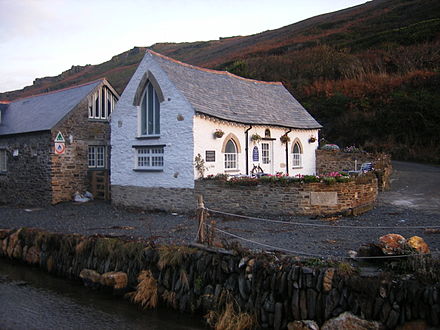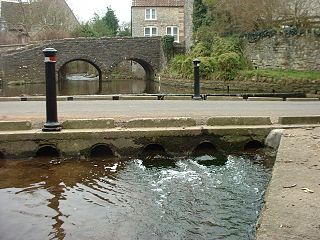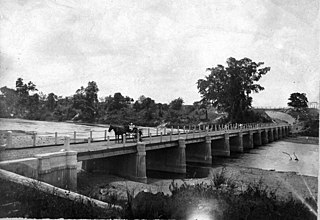This article needs additional citations for verification .(May 2011) (Learn how and when to remove this template message) |
 The old Cornish Stores shop | |
| Date | 16 August 2004 |
|---|---|
| Location | Boscastle; Crackington Haven |
| Deaths | 0 |
| Property damage | Extensive |

The Boscastle flood of 2004 (Cornish : An Lanwes Kastel Boterel 2004) occurred on Monday, 16 August 2004 in the two villages of Boscastle and Crackington Haven [1] in Cornwall, England, United Kingdom. The villages suffered extensive damage after flash floods caused by an exceptional amount of rain that fell over eight hours that afternoon. The flood in Boscastle was filmed and extensively reported but the floods in Crackington Haven and Rocky Valley were not mentioned beyond the local news. The floods were the worst in local memory. A study commissioned by the Environment Agency from hydraulics consulting firm HR Wallingford concluded that it was among the most extreme ever experienced in Britain. The peak flow was about 140 m³/s, between 5:00pm and 6:00pm BST. The annual chance of this (or a greater) flood in any one year is about 1 in 400. [2] The probability each year of the heaviest three-hour rainfall is about 1 in 1300 (although rainfall probability is not the same as flood probability). At midday on 16 August 2004, heavy thundery showers had developed across the South West due to a weak disturbance to the northeast of the United Kingdom. [3]
Cornish is a revived language that became extinct as a first language in the late 18th century. It is a member of the Brittonic Southwestern branch of the Celtic languages of the Indo-European language family, that was native to Cornwall in south-west England. A revival began in the early 20th century. Some have expressed the opinion that the language is an important part of Cornish identity, culture and heritage. Cornish is currently a recognised minority language under the European Charter for Regional or Minority Languages. It has a growing number of second language speakers. A few parents are inspired to create new first language speakers, by teaching their children the language from birth.

Boscastle is a village and fishing port on the north coast of Cornwall, England, UK, in the civil parish of Forrabury and Minster. It is 14 miles (23 km) south of Bude and 5 miles (8 km) northeast of Tintagel. The harbour is a natural inlet protected by two stone harbour walls built in 1584 by Sir Richard Grenville and is the only significant harbour for 20 miles (32 km) along the coast. The village extends up the valleys of the River Valency and River Jordan. Heavy rainfall on 16 August 2004 caused extensive damage to the village.

Crackington Haven is a coastal village in Cornwall, England, United Kingdom. It is in the civil parish of St Gennys at grid reference SX140972 at the head of a cove on the Atlantic coast. The village is seven miles (11 km) south-southwest of Bude and four miles (7 km) north-northeast of Boscastle.
Contents
- Causes of the flood
- Impact of the flood
- Work since the flood
- 2004
- 2005
- 2006
- 2007
- 2008
- The lower bridge
- Mini flood – 21 June 2007
- See also
- References
The last time Boscastle had suffered notable flooding was in 1996 as a result of Hurricane Lili, but floods are recorded in 1847, 1957, on 3 June 1958 (one man drowned) and in 1963. On 16 August 1952 the small town of Lynmouth, 50 miles (80 km) north-east along the north coast in Devon near Exmoor, suffered extensive damage in a catastrophic flood, in which 34 people lost their lives. Coincidentally, this was 52 years to the day before Boscastle's 2004 flood.

A flood is an overflow of water that submerges land that is usually dry. In the sense of "flowing water", the word may also be applied to the inflow of the tide. Floods are an area of study of the discipline hydrology and are of significant concern in agriculture, civil engineering and public health.

Hurricane Lili was a relatively long-lived hurricane of the 1996 Atlantic hurricane season that affected countries from Central America to the United Kingdom. Lili formed on October 14 from a tropical wave, which emerged from the coast of west Africa on October 4. After the storm formed, further strengthening of Lili was gradual, first to tropical storm status on October 16 and then to hurricane status on October 17. The next day, Lili struck Cuba and moved across the central portion of the island, the first hurricane to hit the country since Hurricane Kate in 1985. After emerging into the Atlantic Ocean, the hurricane accelerated northeastward, briefly peaking as a category 3 hurricane on the Saffir-Simpson Hurricane Scale near the Bahamas. For almost an entire week, Hurricane Lili oscillated in intensity while fluctuating several times in forward speed. About two weeks passed before Lili transitioned into an extratropical storm north of the Azores on October 27, which subsequently moved across Ireland and Great Britain.

Lynmouth is a village in Devon, England, on the northern edge of Exmoor. The village straddles the confluence of the West Lyn and East Lyn rivers, in a gorge 700 feet (210 m) below Lynton, which was the only place to expand to once Lynmouth became as built-up as possible. The villages are connected by the Lynton and Lynmouth Cliff Railway, which works two cable-connected cars by gravity, using water tanks.



















